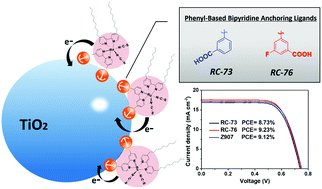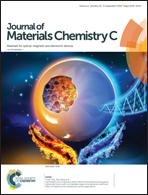Ruthenium complexes as sensitizers with phenyl-based bipyridine anchoring ligands for efficient dye-sensitized solar cells†
Abstract
Two ruthenium complex dye sensitizers, Ru(NCS)2 LL′, in which L refers to 4,4′-dinonyl-2,2′-bipyridine and L′ stands for 4,4′-di(m-X-benzoic acid)-2,2′-bipyridine (X = H (RC-73), F (RC-76)), were designed and synthesized to investigate the influence of introducing phenyl-based bipyridine anchoring ligands and the performance of dye-sensitized solar cells based on them. With the modification of conventional 4,4′-dicarboxylic-2,2′-bipyridyl anchoring ligands with phenyl-based bipyridine units, both RC dyes show superior photophysical and electrochemical properties, resulting in excellent device performance. Remarkably, with the enhancement of the electron-withdrawing ability of X, RC-76 has more satisfactory properties in absorption intensity, redox potential, electron transport and dye regeneration, which can be confirmed by UV-vis absorption spectroscopy, cyclic voltammetric measurement, density functional theory calculations and transient absorption spectroscopy. The devices based on RC-76 achieve a short-circuit current density of 17.52 mA cm−2 and a power conversion efficiency of 9.23%. The kinetics study and electrical impedance spectroscopy explain the causes of the inferior open-circuit voltage of RC dyes compared to that of standard Z907 dye. RC dyes, represented by RC-76, exhibit good long-term stability and the corresponding solar cells retain over 90% of the initial power conversion efficiency after 1000 h.



 Please wait while we load your content...
Please wait while we load your content...